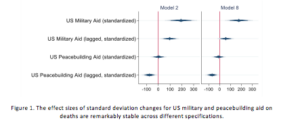Although a general consensus has built around the notion that third-party assistance mediates and reduces conflict in recipient countries, a more recent strand of literature has begun to suggest that the type and / or source of this assistance might matter. In this study, we explore effects of two specific forms of aid designed to reduce violence and conflict: security sector assistance (akin to military assistance); and peacebuilding assistance. In the first stage of our analyses, we test the impact of each form of aid on political violence across a sample of fragile and conflict-affected states. In the second stage, we test the indirect impact of aid on GDP via its intermediate effect on violence. We use coarsened exact matching to overcome the typical endogeneities associated with aid allocation and structural equation models to estimate our two-step outcomes. While peacebuilding assistance shows the anticipated downward impact on the intensity of violence, security sector assistance is shown to lead to increased intensity. Our second-stage results confirm the anticipated negative relationship between the extent of violence and GDP. Post-estimation analyses suggest an expenditure of $120k-150k per life saved via peacebuilding assistance, which corresponds to a mean increase in GDP of $9,240 per life saved. Given the total (economic) harm linked to violence, we note that this likely highly underestimates the total benefits of peacebuilding assistance.
Publication Details
- Year of Publication: 2018
- Region/s: Global
- Theme/s: Impact Evaluation · Violence & Peacebuilding
- Research Topic/s: Peacebuilding & Reconstruction · Violence & Conflict
- Method/s: Panel Data Analysis · Quasi-Experimental Designs




